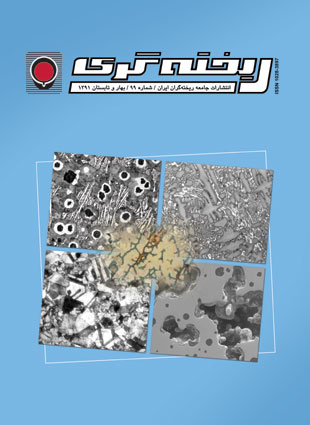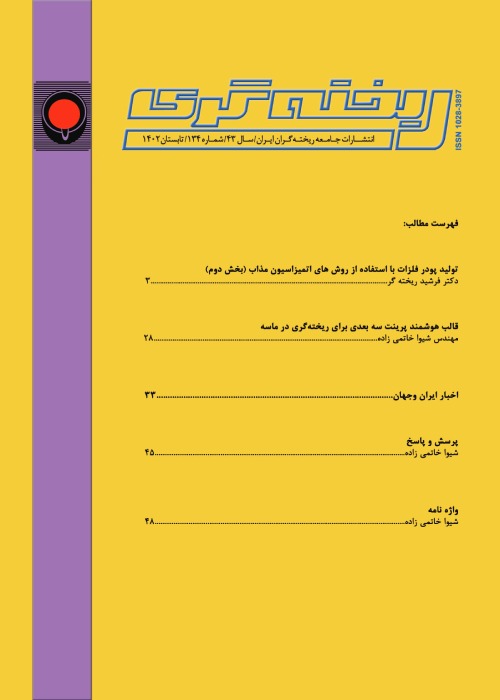فهرست مطالب

نشریه ریخته گری
پیاپی 99 (بهار و تابستان 1391)
- تاریخ انتشار: 1391/05/19
- تعداد عناوین: 8
-
-
Page 2In this study, the semisolid Aluminum alloy A356 was stirring by using electromagnetic stirring under different conditions of current intensity, pouring temperature and stirring times. To evaluate the effects of these conditions on globular grain refining, the Maxwell simulator software was used. The practical results shows increasing in stirring current and stirring time and reducing pouring temperature convert the conventional and rosette microstructure to globular. The 70 Am current intensity, Electromagnetic intensity 0.09 Tesla, and pouring temperature 650 will cause the optimum conditions.Keywords: Semisolid process, Electromagneticstirring, Globular Microstructure, A356 Aluminum Alloy
-
Page 10In the present study the influence of different kinds of grain refiners on microstructure, mechanical properties of thin ductile castings have been investigated. Three grain refiners that have been used are pure ferro-silicon, Fe-Si-Sr, and Fe-Si-Zr at 0.1%(wt) and samples were strips with different thicknesses from 0.3 to 4 mm. Chemical composition of the melt was 3.3%C, 3.62%Si, 0.22 Mn,and 0.032%Mg with CE=4.5% and pouring temperature 1400 ○C. Microstructures have been investigated by Optical Microscopy. The results of mechanical properties and microstructure analysis show, samples that are grain refined with pure Fe-Si have not enough nodularity comparing with two other grain refiners and Fe-Si Sr had better effect on reduction of micro-shrinkage, chill depth, carbide forming and had higher mechanical properties. In Si-Fe-Sr grian refined samples UTS was 15% higher and elongation rised from 1.25% to 3% and also comparing with Fe-Si-Zr in samples with 1mm thickness micro-shrinkages were smaller
-
Comparing Microstructure and Chemical Composition of Ti6Al4V Alloy produced by ESM and VAM ProcessesPage 18In the present study ESM and VAM melting processes have been used for producing Ti A 4V alloy. Chemical composition were determined on a line along the height of the samples by an Optical Emission Spectrometer. The castings were also hot rolled and heat treated. Microstructure of samples in as cast and thermo-mechanical conditions were investigated by Optical Microscope. The results show that the chemical composition and the microstructure in VAM samples are more homogenous
-
Page 24Today most of automotive producers use brake disk in front axial. So it is one of the most safety parts in automotive industry. Because of special characteristics such as good heat transfer, damping capacity, and good machinability, Gray cast Iron is common material for making brake disks. This research, involve more than 20 years experiences in casting, heat treatment and machining of brake disks in Iranian companies. One of very important cases in decrease of driving quality is evades geometrical tolerances such as run-out, parallelism, etc in machining process. Another case is evades balance descended mold mismatch in casting process. These cases motivate wheel shake during driving or brake application. Therefore in this research, the machining of brake disk by best method in production process, for access the best quality and stability production process is reviewed.Keywords: brake disk, disk, Casting, machining of cast irons, cast iron parts, Stress realization heat treatment
-
Page 32The mechanism for initiation of Segregation Hot Tears have been investigated in this study. Also density of Hot Tear defects from surface to the centre of blooms produced by continuous casting and possibility of moving Hot tears towards surface during production of final products have been studied. Two industrial steel samples have been chosen for Metallographic and Electron mmicroscopic studies. The results show Segregation Hot Tears first appears as spheral particles of Mn-sulfide or as longitudinal cracks full of Fe with high concentration of Mn and S, but after that with the effect of stress, open hot cracks forms around spheral particles of Mn-sulfide. As the density of Hot Tear defects become more towards the surface, during final production process these defects reach the surface which deteriorate surface.
-
Page 38Multi-walled carbon nanotubes (MWCNTs) should be attractive for the reinforcement of metal-matrix composites, because of their high strength, high modulus and high thermal conductivity. In this study, the effect of squeeze pressure on mechanical properties and microstructure of cast metal matrix composite A356- MWCNT was studied. Special amount of Al-MWCNT fibers produced by accumulative rollbondingprocess and A356 and Ai-13% Aluminum ingots were melted in a crucible furnace. This mixture was solidified under different pressures by squeeze casting process. The results shows increase in tensile, shear and bending strength and hardness and decrease in DAS by adding the carbon nanotubes and squeeze pressure..Keywords: Aluminum nanocomposite, carbon nanotube, Squeeze casting, Mechanical Properties, Microstructure
-
Page 45In this research, aluminum powder and alumina were milled in a high-energy planetary mill at different times to manufacture capsules of powdery composites (Al-Al2O3)CP. Then, these capsules were added to aluminum melt and cast through ex-situ. Scanning electron microscope was used to study the morphology of the capsules and the microstructure of the cast composites. The percentage of capsules and reinforcement particles in cast composite were measured by utilizing Image Tool software. By optimizing the milling time to 5 hours, the percentage of the reinforcing particles in the cast composite matrix increased dramatically; moreover, the weight of the sample in the wear test was significantly reduced and the wear mechanism shifted from adhesive to abrasive.Keywords: Aluminum, alumina, Milling, Composite, Ex, situ casting, Wear resistance
-
Page 52The present study is an inquiry on the field of education of science and engineering of materials in Iran. The dual scientific and engineering nature of the education of materials is explained firstly. A brief look is taken at the position of this studing branch in Iran and the world. The requirements of training of this branch are considered using the mentioned dual viewpoint. Since it is essential to adjust the studing program of each branch to the specifications of the related country, the aouthers tried to consider the aspects of training of materials branch which has not been well analysed by the experts. Eight noteworthy points are analyses in this field. The effort was to propose a solution for each of the mentioned cases, using a semi student semi lecturer viewpoint.


